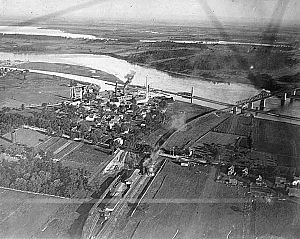Cornwall Canal facts for kids
The Cornwall Canal was a special waterway built in Canada. Its main job was to help ships get around some tricky, fast-moving water called "rapids" on the Saint Lawrence River. These rapids were near a town called Cornwall, Ontario. The canal was started in 1834 and finished in 1843.
What Was the Cornwall Canal?
The Cornwall Canal was like a shortcut for ships. It stretched from Cornwall, Ontario, past the Long Sault rapids, all the way to a place called Dickinson's Landing. The canal itself was about eleven miles long.
How Did the Canal Work?
To help ships move up or down different water levels, the canal had six special sections called locks. A lock is like a water elevator for boats. Each lock was quite big, measuring 270 feet long and 45 feet wide.
When a ship entered a lock, gates would close. Water would then either be added or removed to raise or lower the ship to the next water level. The Cornwall Canal's locks could raise or lower ships a total of 48 feet. The water inside the canal was 14 feet deep. At its bottom, the canal was 100 feet wide, and at the water's surface, it was 164 feet wide.
Why Did the Canal Close?
The Cornwall Canal was used for many years, but it eventually closed in 1968. It was replaced by a newer, bigger canal system called the Wiley-Dondero Canal. This new canal was built on the United States side of the Saint Lawrence River and could handle larger, more modern ships.


